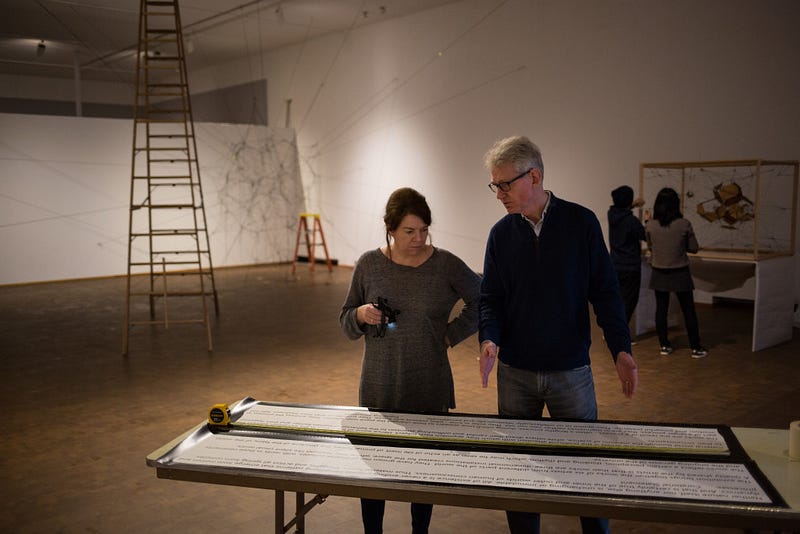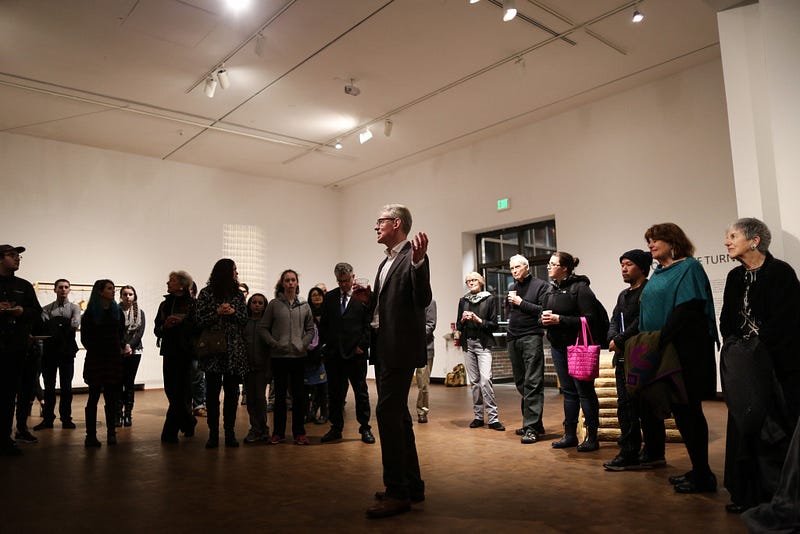Hafthor Yngvason: Combining Philosophy and Art
Western Gallery’s new Director brings a philosophical approach to campus’ art collection
STORY BY KENNETH CLARKSON | PHOTOS BY NICK DANIELSON
Hafthor Yngvason will be the first to tell you he is not an artist. Yngvason is a philosopher; one who happens to be the Western Gallery’s new director. In his office there is an air of minimalism. Solid orange walls surround towers of paper and there is no incomprehensibly abstract artwork on display. He bolts up out of his office chair and heads toward the Western Gallery’s entrance. It is two weeks before the opening night of his first exhibit as the gallery’s director.
Artist Rintaro Hara is hard at work at the back of the gallery. His piece titled “Uplift and Slope” will be on display during the exhibit. Hara flew in from Japan to set up his installation. He says it will take the entire two weeks to complete.
Only one other artist travelled to complete their installation. The remaining four works have been installed by Museum Preservation Specialist, Paul Brower and a team of students.
Hara brandishes a few Styrofoam balls in his left hand. “I will use these, string and vertical beams to create my piece,” he says.
Once Hara is finished, tiny Styrofoam balls will travel on nearly invisible string. Standing in the middle of the gallery, one gets the feeling as if they are watching atoms travel back and forth, gliding past each other with extreme precision.
As Yngvason admires the production of the exhibit, he also admires the philosophy behind it.

The first major exhibit Yngvason will present at Western, called “How Space Turns” (Wie Raum Wird), shows from Feb. 5 to May 12. This particular presentation was shipped from Germany to Bellingham. The exhibit will feature the work of six different artists, two being from Iceland.


While working as the director of the Reykjavik Art Museum, Yngvason featured the same exhibit in 2014. It was received so well in Iceland it then traveled to Frankfurt, Germany. Yngvason was lucky enough to see it shipped to Western after it went off display in Frankfurt.
Born and raised in Reykjavik, Iceland, Yngvason formulated his initial interest in art when he was 16 years old. In Iceland, high school students study a concentrated topic before going to college. Yngvason studied physics and mathematics, he recalls with a laugh.
“Those were the easy subjects for me, but I became more and more interested in philosophy,” Yngvason says. Yngvason wanted to study philosophy and art in order to understand and explain art to others in a theoretical manner.
Yngvason switched his plan of study and graduated from the University of Iceland with a degree in philosophy.

He pauses, remembering his first time off of the island. Following a short visit to Boston he decided to finish his Master’s degree in philosophy at the University of New Mexico.
“I went as far as I could from Iceland, I wanted to experience a new culture,” Yngvason says.
In addition to wanting to experience a different lifestyle, he was drawn to New Mexico because of the opportunity to study at the D.H. Lawrence Ranch.
Lawrence was a prominent English novelist, playwright and painter during the 1920s.
After achieving his Master’s degree in philosophy Yngvason moved again, this time to Cambridge, Massachusetts to continue his studies at Harvard University.
Yngvason began to study under world-renowned philosopher, Stanley Cavell, known for his study of the philosophical principles of skepticism, aesthetics and ethics.
Following his studies at Harvard, Yngvason became the director of public art for the City of Cambridge. In 2005, he was given the opportunity to go back to Reykjavik, but this time as the Director of The Reykjavik Art Museum.
Come 2015 Yngvason needed to find a new job. He began to look at different art museums all over the U.S. to find work.
During his time at Cambridge, Yngvason he heard about Western’s outdoor public sculpture collection. Yngvason explains the collection is well-known outside of Bellingham and loves how it offers hands-on interaction with art for the students at Western.

Standing at the entrance to the gallery he scans the room eyeing the space that will hold his first exhibit at Western.The sculpture collection at Western reminds him of work he accomplished while working in Reykjavik. Pleased with his work he strides back toward his office, a smile on his face. He sits down at his desk and turns on his computer. He is back to clicking away at emails. Remember, Yngvason is not an artist.
